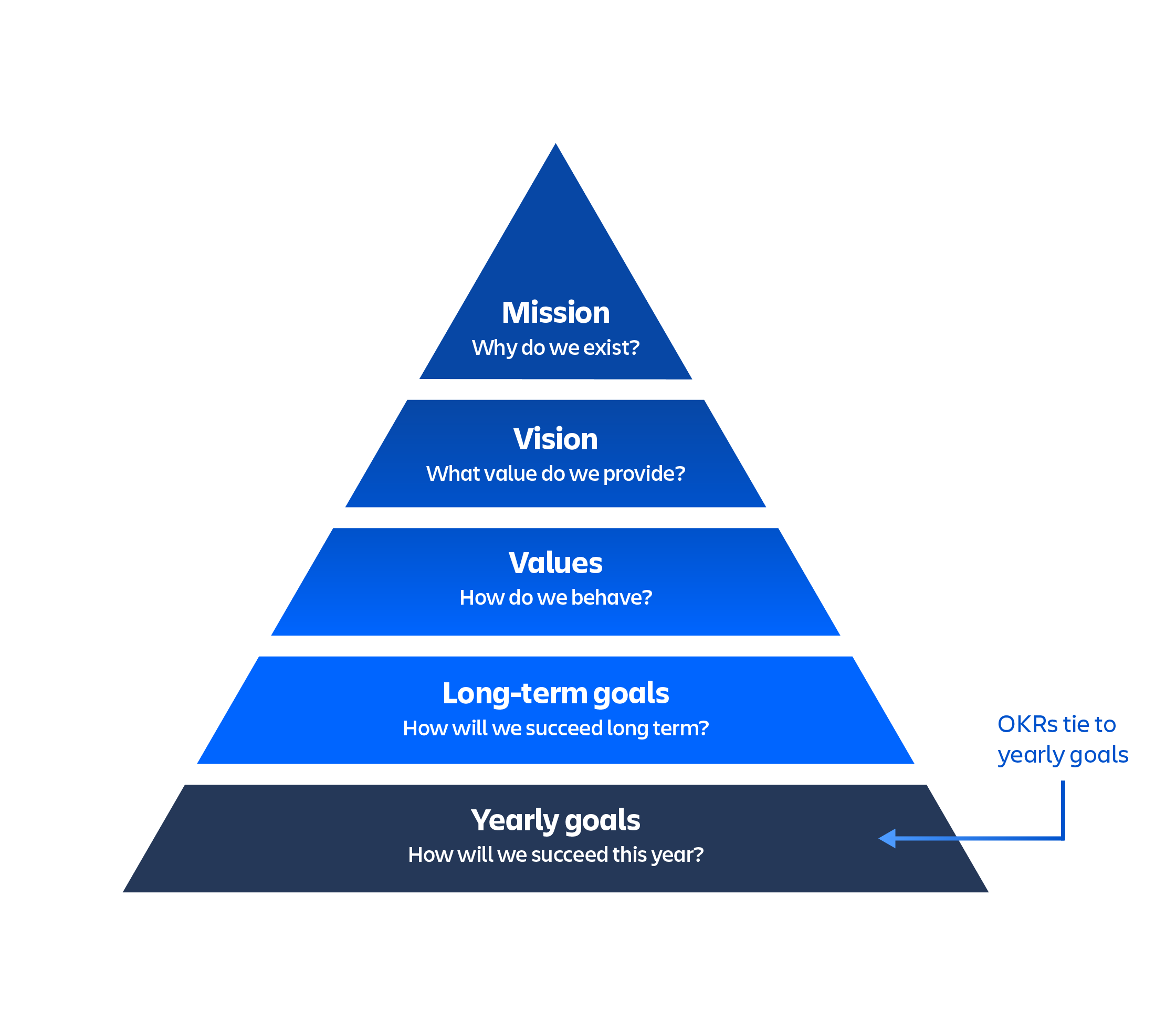When you want to achieve something, anything, your desires are based on a preferred outcome. It’s a very simple, basic human concept developed at an early age. One way of putting it into a sentence is:
I will ________ as measured by ____________.
This is how John Doerr explained objectives and key results (OKR) in his book Measure what Matters. While it’s a simple concept, the business world is a complex place with many moving parts. Still, by adhering to simple principles, big results can manifest.

What is an OKR?
An OKR is a popular management strategy that defines objectives and tracks results. It helps create alignment and engagement around measurable goals. Introduced and popularized in the 1970s at Intel, it has since spread throughout technology companies as a way to help employees understand and be engaged in an enterprise's charter. Studies show that team members are more engaged in their work and more productive when they have a clear idea of what the team is trying to achieve and, more importantly, the significance of the task.
"When employees perceive their jobs as high in task significance, they display higher job performance."
--“The Significance of Task Significance: Job Performance Effects, Relational Mechanisms, and Boundary Conditions,” in the Journal of Applied Psychology.
OKRs are a refinement of a widely used practice of management by objectives (MBO). The difference is that OKRs are a more collaborative process as opposed to a top-down bureaucratic process. Peter Drucker – who first popularized MBO – suggested that a manager should review the organization's goals and then set the worker's objectives. In contrast, OKRs rely on the teams within the organization to take high-level objectives and refine them for each specific area. And if teams have to work with other partners in the organization to reach high-level objectives, those teams might collaborate and write OKRs together to ensure proper alignment. It’s a shift in mindset where the question changes from "were we busy doing the tasks?" to "did we move the needle for our organization to thrive?"
It’s more useful to think about the “OKR process” than it is to just consider the “objective” and the “key result” bits. Static goals that aren’t regularly reviewed and revised as the operating environment changes quickly become stale and meaningless. Combining clear objectives with a small set of specific, measurable results and a regular process of reviewing progress toward those measures is what makes OKRs truly useful.
Defining OKRs
OKRs have two important parts: The objective you want to achieve and the key results, which are the way you measure achieving the objective.
Felipe Castro, an OKR coach, author, speaker, and evangelist, summarizes the two components of an OKR:
Objectives: are memorable, qualitative descriptions of what you want to achieve. Objectives should be short, inspirational, and engaging. An objective should motivate and challenge the team.
Key results: are a set of metrics that measure your progress towards the objective. For each objective, you should have a set of two to five key results. More than that and no one will remember them.
There are a couple of key points in this definition. First, the objective should be concise and engaging, so a team can easily remember it. Next, there should be a small number of metrics to track the key results. These metrics should be something you can measure on a timely basis. If you can only see the results after two years, it’s not possible to review your progress on a quarterly basis.
Examples of objectives
As Steven Covey wrote in The Seven Habits of Highly Successful People, “begin with the end in mind.” That fits perfectly with identifying the objectives you want to reach.
Some high-level objectives are:
- Improve customer satisfaction
- Increase recurring revenue
- Scale system performance
- Increase the number of customers served
- Reduce the number of data errors in the system
The important thing for each enterprise is to identify the objectives that are relevant to a specific context (market forces, customer requirements, competitive landscape, regulatory environment, etc.) And the objectives should help guide the activities of each of the teams within the organization. Having an objective of “be profitable” is fine for most companies, but that objective is so high-level it doesn’t help teams determine how they’re going to “be profitable.” Framing objectives in terms of “what can we achieve in the next quarter to help us reach our long-term goals” helps teams focus their efforts into smaller steps that allow for regular reflection and realignment of activities.
Examples of key results
“Key results” are the desired outcome after taking a set of actions. A common mistake with OKRs is confusing desired outcomes with actions used to reach objectives. For example, in the case below, the objective is to reduce the number of data errors in the system. But the specified key result is the installation of a new vendor package release. However, there’s no mention of tracked data errors or the future goal. There’s no way of knowing if installing the latest release made things better, worse, or had no effect.
 What NOT to do: Mistake the actions taken to achieve an objective as the key result. For example:
What NOT to do: Mistake the actions taken to achieve an objective as the key result. For example:
Objectives: Reduce the number of data errors in the system
Key results: Installation of release 10.0 of the vendor package
In the example below, we show how to keep the same objective and specify key results that tracks if improvements are achieved. There may be many different activities done in concert to achieve the desired objective.
 What to do: Identify measurable results:
What to do: Identify measurable results:
Objectives: Reduce the number of data errors in the system
Key results:
- as measured by the number of data quality errors reported to the support desk
- as measured by the number of orders that can’t be filled automatically
- as measured by the order errors reported by customers
Matching objectives and key results
It’s important to find key results that are leading indicators of your objective, as opposed to lagging indicators. You want results that can be measured regularly and frequently, and lead to the overall objective.
Objective | Metric |
|---|---|
| Customer satisfaction | Net promoter scores Survey results Customer churn Adoption rate Engagement Market share (vs competition) Conversion rates |
| Recurring revenue | Quarterly revenue Subscriptions |
| System performance | Simultaneous users Number of customers Number of performance complaints Number of monitoring system triggered critical events |
Tracking success with OKRs
Scores – A sliding scale between 0 and 1 that indicates whether you missed, came close to, or hit your stated target for the KR. For example:
.3 = you missed the mark by quite a lot
.7 = you didn't hit your target but made great progress
1 = you hit your stretch target (awwwww yeah...)
That's right: scoring .7 on a key result is considered a success! You should set ambitious stretch goals and not feel like a failure if you end the quarter without a perfect score.
If you are regularly scoring 1.0 on your results, you might want to make sure your key result targets are a little more ambitious.
At Atlassian, we use a simple confluence template to score our OKRs and communicate our progress to the broader org.
OKRs and agile development
Agile development and OKRs go together perfectly. It's been said that agile development decreases the costs of changing your mind. That’s because agile planning calls for a regular, planned cadence of checking the progress of development, evaluating the context of the enterprise (the competition, customer requirements, regulatory requirements, market conditions), and making adjustments based on this information. Having clearly communicated objectives and key results provides transparency.
A quarterly review can shift from “did we deliver the things we said we’d deliver?” to “did we achieve the objectives we wanted?” Combining those two questions helps an organization decide whether to continue on its path or modify it.
Aligning OKRs to business strategy
When establishing OKRs, it is important not to lose sight of what's guiding your organization. Therefore, you should align top-line OKRs with your organization’s mission, vision, and “north star” values. Where OKRs help define the "what" and the "how," your vision should enforce the "why." This cascading diagram helps illustrate how a company's vision should be linked to both your annual and quarterly OKRs. It also shows where OKRs fit within the overall strategic planning exercise.

Your objectives should support your mission and your company’s values, but they should be tightly aligned to your long-term and short-term (or 1 year) goals.
Getting started with OKRs
One way to introduce OKRs is to have an organization identify three or four objectives it wants to achieve for the entire year. This is usually done at the CEO level. Then have each part of the organization identify related objectives they can achieve in each of the four quarters in the year. This mix of a big yearly target with the smaller quarters can help the organization learn how objectives in one particular area contribute to the entire organization.
It’s important to identify measurable key results so you can check progress toward your objective. If you set a key result that can only be measured once a year, you’ll only have one chance per year to know if your work helps you reach your objectives. As organizations deal with the increasing pace of change, checking progress once per year isn’t enough.
If you would like more guidance on the process of establishing and scoring OKRs, check out this OKRs play.
How Jira Align can help
Atlassian’s Jira Align solution helps connect your business strategy to technical execution. Where OKRs track the results of execution, Jira Align provides a clear insight into objectives, key results you track, and the work toward delivering objectives. The OKR features natively included in Jira Align help your team get aligned, stay aligned, and instantly connect work with value delivery.
Curious to learn more about how OKRs can help focus your organizational strategy and drive alignment on an ongoing basis? Watch our on-demand webinar.
Special thanks to Caz Gottlieb, Associate Product Manager, Jira Align for her contributions to this article.
